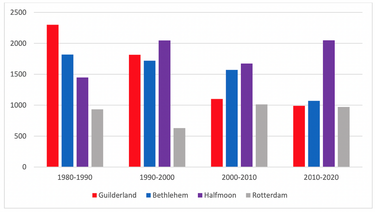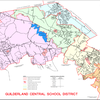With comprehensive plan on the horizon, Guilderland takes stock of its past
GUILDERLAND — As Guilderland prepares to move forward with an update to its 20-year-old comprehensive plan, a document designed to guide its long-term decision-making, the town is first looking to its past for help with creating the underpinnings of a “solid foundation” on which the update process can begin.
Aiding Guilderland in that endeavor is a recent report by the Capital District Regional Planning Commission that examines how the town has changed since 1990.
The study looked at 30 years of development, demographic, and economic trends in town, and arrived at the conclusion that, generally speaking, development has declined in the years since the town last updated its comprehensive plan.
In recent years, the town has been issuing more permits for multi-family dwellings than for single-family homes. Still, more than two-thirds of the town’s 16,000 total housing units are single-family homes.
And the report found that Guilderland residents are among the best-educated and compensated in the area, with well over half having earned either a bachelor’s, graduate, or professional degree.
“For any municipality to successfully plan for its future, it must first understand its history and makeup,” states the study from the commission. That understanding is an “important starting point for discussing the Town’s vision for the future as it updates the 2001 Comprehensive Plan.”
A comprehensive plan, according to New York State, “should provide the backbone for the local zoning law … [it’s] the culmination of a planning process that establishes the official land use policy of a community and presents goals and a vision for the future that guides official decision-making.”
Housing
The rate of homebuilding in Guilderland has declined “significantly since the blistering pace” of the 1980s and ’90s, the study found.
But the trend is not unusual for the area, according to the study; rather, it “reflects very similar patterns with the neighboring peer communities of Bethlehem and Rotterdam.”
The study says there are benefits to comparing what’s happened in Guilderland over the past 30 years to events that have taken place at the regional, state, and national levels in that time.
But the commission also says it’s “beneficial to compare Guilderland to peer communities in the Capital Region that are geographically and demographically similar and have experienced recent growth.” By comparing Guilderland to Bethlehem, Halfmoon, and Rotterdam it can be beneficial in helping determine “if Guilderland is on trend with its peers or is an outlier in specific categories,” the study says.
To that end, “Growth in Guilderland mirrors regional and national trends,” the study states.
Single-family home development, the study says, has happened throughout the town, while multi-family units have largely been built near established population centers, with the heaviest concentration of multi-family home construction taking place near Western Avenue in the Westmere and McKownville neighborhoods.
Between 1980 and 2020, the total number of housing units in Guilderland increased by about 63 percent, according to the study, from about 9,800 in 1980 to approximately 16,000 in 2020.
But each decade saw fewer units being built than the preceding 10-year period, a “trend shared by some other peer towns in the region,” according to the study; Guilderland saw growth similar to that of Bethlehem and Rotterdam.
Between 1980 and 1990, there were 2,301 housing units built in Guilderland; between 1990 and 2000, there were 1,814 units added; between 2000 and 2010, the town added 1,101 housing units; and between 2010 and 2020, just 989 units were built, according to the study.
The study then looked at building-permit issuance to examine the types of homes built in town over the past 30 years.
Between 1990 and 2020, Guilderland issued a total of 4,992 building permits, according to the study, with 55 percent issued for single-family construction and the remaining 45 percent for multi-family units.
The number of single-family homes built between 1990 and 2020 and the number of single-family permits issued over that period were “very close” to the same number, the study says, citing the town’s certificate-of-occupancy data, meaning people were able to move into those new homes.
Between 1990 and 2000, when 1,814 units were added to Guilderland’s housing stock, there were 1,562 single-family permits issued. Between 2000 and 2010, when the town added 1,101 housing units, 774 permits were for single-family homes. And between 2010 and 2020, which saw the addition of 989 units in town, there were 551 single-family permits.
But more recently, the town has been issuing more multi-family permits than single-family, the study states, between 2017 and 2020, “Guilderland issued more building permits for multi-family units [464] than for single-family units [126].”
Like its peer towns, Guilderland is “dominated” by single-family homes, the study says; 68 percent of its approximately 16,000 total housing units are single-family. While the remaining 32 percent of Guilderland’s housing stock breaks down as follows:
— Buildings with between two and nine units account for 19 percent;
— Buildings with between 10 and 19 units account for 7 percent; and
— Twenty-or-more unit structures account for 6 percent.
The study then looked at the “complex issue” of housing affordability in town, citing a federal recommendation that says no more than 30 percent of a household’s income should be spent on housing costs. Guilderland’s median household income is $86,180, or $7,182 per month, according to the study.
Seventy-percent of the town’s owner-occupied homes have a monthly mortgage mortgage payment under $2,000, with the remaining 30 percent paying as follows: 16 percent pay more than $2,000 per month; 6 percent pay between $2,500 and $2,999; and 8 percent pay more than $3,000 per month.
Moving on to rental units, the study says, they are “more affordable, [but] there are fewer of them.” While Guilderland renters may pay less per month than their home-owning counterparts in town, they are paying more than other area renters.
Sixty-three percent of Guilderland renters pay between $1,000 and $1,499 for monthly housing costs, which is a significantly larger portion of renters when compared to the rest of the area. In the Albany-Schenectady-Troy Metropolitan Statistical Area — which consists of Albany, Rensselaer, Saratoga, Schenectady, and Schoharie counties — 33 percent of renters pay between $1,000 and $1,499 per month, according to the study.
The study also looked at available data to see how much traffic had increased in town.
Daily volumes were collected for 16 roadway segments — eight were along Western Avenue alone, with the remaining observation points located along state Route 146, and Carman, State Farm, Johnston, Fuller, and Old State roads. Since 2000, the data suggests “there has been little/no growth in traffic volumes, and in some cases negative growth.”
Just six of the 16 road segments monitored for the study saw annual increases in traffic, none more than 1.9 percent; however, those observation points were located either along Western Avenue or were a segment of roadway that had been measured from Western Avenue to another point.
Demographics
Guilderland is both an aging community and one with a higher percentage of college-age residents than the rest of the country.
The town has, at about 17.2 percent, “the highest share of citizens 65 years of age or older, compared to Albany County, New York State and the national average,” according to the study while 14 percent of residents are between the ages of 18 and 24, which “is likely due to part of UAlbany’s residential housing being located within Guilderland’s boundaries.”
But, compared to its local peers, Guilderland (as well as Halfmoon) has the lowest share of 65-and-older residents. Bethlehem has the highest, at 19 percent, then Rotterdam, at 18 percent.
Among the remaining age cohorts, Guilderland, with 24 percent of its residents between the ages of 24 and 44, is below the national average of 26 percent in the young-adult cohort, the study says.
At 27 percent, “Guilderland has the lowest share of adults [45 to 64] compared to its peer communities,” according to the study, while among its remaining age cohorts, the town is in line with its peer communities, with school-age children, five to 17 years old, making up 14 to 15 percent of the town’s population, and preschool-aged children accounting for 5 to 6 percent.
By “categorizing populations into age cohorts, [it] helps to better understand the different types of services communities need,” the study states. “Age cohorts combine similar age years with similarities into one group to better allow for analysis and comparison.”
For example, according to the report, “A higher percentage of residents under the age of 15 may imply the need for emphasis on schools, primary health care services, and recreational needs. In contrast, a higher percentage of a population that is 65+ may require easier access to health care facilities and specialized transportation modes and facilities.”
When it comes to the racial and ethnic makeup of its residents, the report says, “Guilderland is extremely similar to the makeup of the region.” The town is predominantly white, with 77 percent of the population estimated to be non-Hispanic white.
The study says Guilderland’s Asian population, about 11 percent, “is higher than the regional, State, and National level,” respectively, 8 percent, 10 percent, and 6 percent.
The study also notes the 2020 Census “saw many more people identifying as races other than White, or Two or More Races than had been in previous censuses,” and that “White Alone populations saw a significant decrease across the region while other races or people identifying as multiple races saw increases.”
The study surmises that people who previously identified as white alone changed “their classifications to reflect other races they have in combination with White.”
When it comes to educational achievement, Guilderland’s residents are ahead of the pack.
At nearly 27 percent, the number of Guilderland residents with a graduate or professional degree is more than doubled the national average of approximately 12 percent. The number of town residents with a bachelor’s degree, 26 percent, is also higher than the national average of about 19 percent.
Just 3 percent of residents did not complete high school, less than a quarter of the national average of 12.6 percent.
Income
The median household income in Guilderland is about $86,000 per year, according to the report, which is about 20 percent higher than the median income of households in the Albany-Schenectady-Troy Metro Area.
Approximately 60 percent of Guilderland residents’ occupations were in management, business, science, and the arts, according to the study, which is significantly higher than state and national averages of 43 percent and 38 percent, respectively.
The study says there were about 17,770 employed individuals living in Guilderland in 2018, and that over 87 percent, about 15,800, were employed outside of the town while there were about 13,400 individuals employed in Guilderland who lived elsewhere.
The study then looked at the revenue breakdown from each employment sector in town because looking at “revenue generation by sector in a community helps the evaluation of overall strengths and weaknesses of a community’s economy.”
Wholesale trade — businesses that sell goods to other businesses — was by far the highest revenue generator in Guilderland, approximately $575 million as of 2019. And was followed by the retail — businesses that sell goods to the public — and healthcare-and-social assistance sectors, which generated $330 million and $269 million in revenue in 2019, respectively.
The town itself generates a significant portion of its revenue through sales- and use taxes, which totaled about $12 million in 2019, according to the study, and real property taxes, about $8.8 million.
The other significant pot of Guilderland tax dollars comes from “charges to other governments, other non-property taxes, use and sale of property, and other local revenues such as fines, gifts and compensation for loss,” which, according to the report, totaled nearly $3 million in 2019.
“Understanding Guilderland’s tax revenue streams, labor force participation, employment rates, occupations, and commuting habits is important for anticipating and planning for needs in housing, transportation infrastructure, land use and zoning, and Town services,” the study states.



